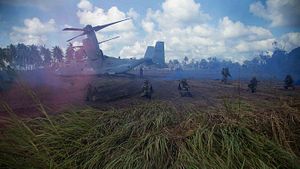Over the weekend, the United States and Malaysia kicked off another iteration of a key bilateral exercise focused on amphibious operations. The holding of the drills was yet another demonstration of continued cooperation on the defense side under the new U.S. administration led by President Donald Trump.
As I have noted previously, despite some lingering differences, the United States and Malaysia enjoy a strong defense relationship, as manifested across a range of areas such as counterterrorism and maritime security, and through a variety of means including visits, exchanges, and exercises (See: “Malaysia’s Approach to the South China Sea and Implications for the United States”).
With respect to exercises, these include Malaysia’s participation in multilateral ones like Pacific Partnership and the Southeast Asia Cooperation and Training (SEACAT) as well as bilateral ones such as Exercise Keris Strike. These interactions have largely continued on during the Trump administration, albeit with some minor changes. In September, for instance, both sides conducted a maritime training activity following the summit meeting between Malaysian Prime Minister Najib Razak and Trump (See: “The Real Test for US-Malaysia Relations in the Trump Era”).
One of the exercises the two sides have conducted is Exercise Tiger Strike, a bilateral training exercise designed to both strengthen combat readiness and to help plan and execute amphibious operations. Last year’s iteration of Tiger Strike saw the participation of about 300 Marines and Sailors with the Marine Expeditionary Unit on the U.S. side and featured the sharing of training practices in various areas including combat logistics support and operational planning.
On November 18, the United States and Malaysia kicked off Exercise Tiger Strike 2017 as scheduled in Tanduo. TS17 was the fourth iteration of the exercise, and according to a Malaysian defense ministry statement, the drills, which will last until November 23, involved over 400 personnel from both sides.
The headlines about the exercise in Malaysian media outlets were tied to the exercise focus on fighting off militants. That was no surprise since Tanduo was at the center of the Lahad Datu incident in 2013, which saw over 200 descendants of the sultanate attempting to assert the Philippine claim to Sabah, leaving dozens of militants, civilians, and Malaysian security forces dead. Though Sabah is currently one of Malaysia’s 13 states, there is a longstanding dispute with the Philippines tied to the claim of the sultanate of Sulu, which had ruled over parts of Sabah before the British transferred it to the Federation of Malaysia in 1963.
The choice of location is consistent with Malaysia’s focus on combating terrorism around the Sabah area, which is a key priority area for its defense as well as the broader preservation of its sovereignty. More broadly, Sheikh Mokhsin, the Malaysian Armed Forces assistant chief staff for operations and training, also emphasized that the drills helped enhance the capabilities of both sides and enhance interoperability.

































